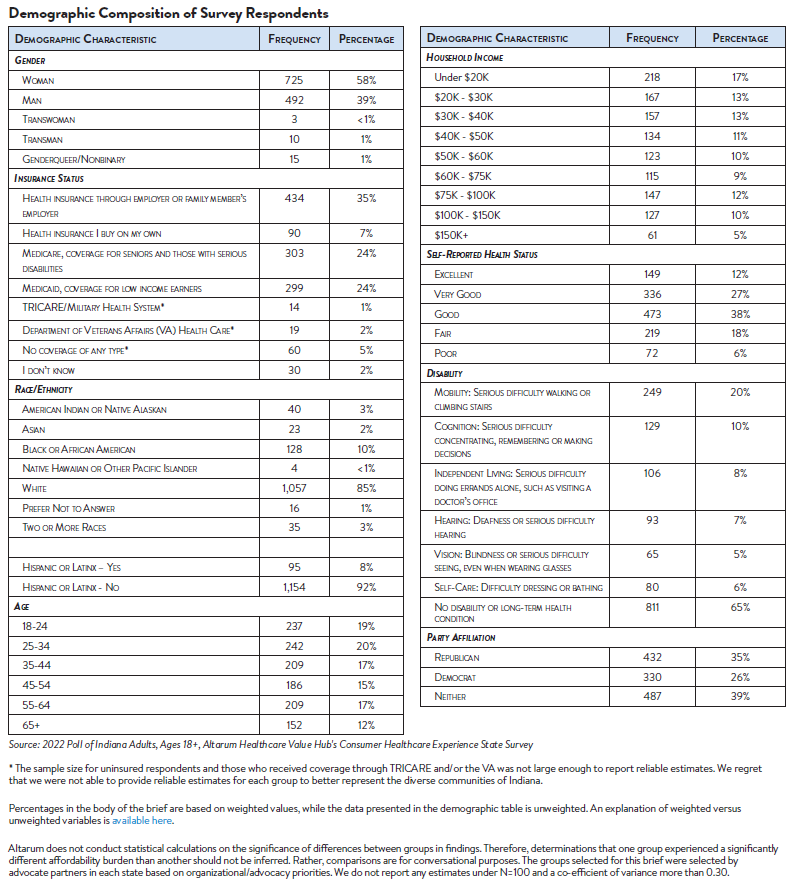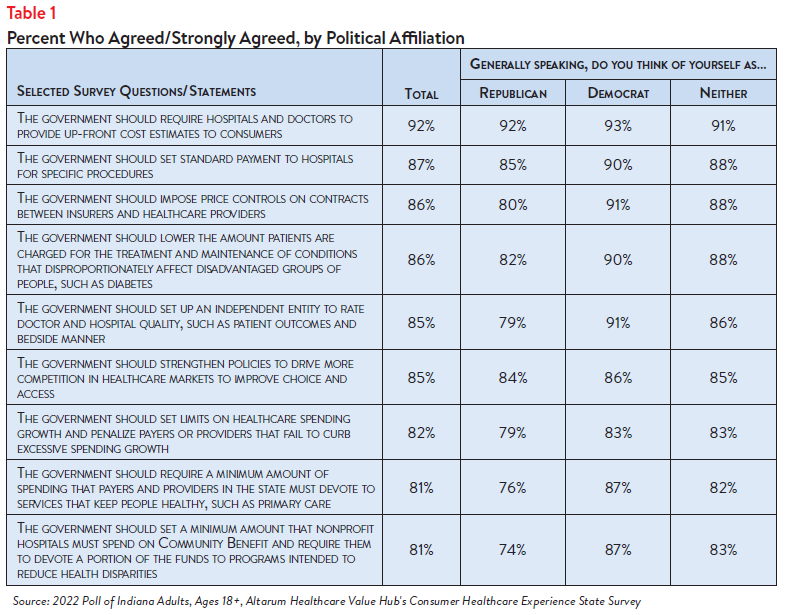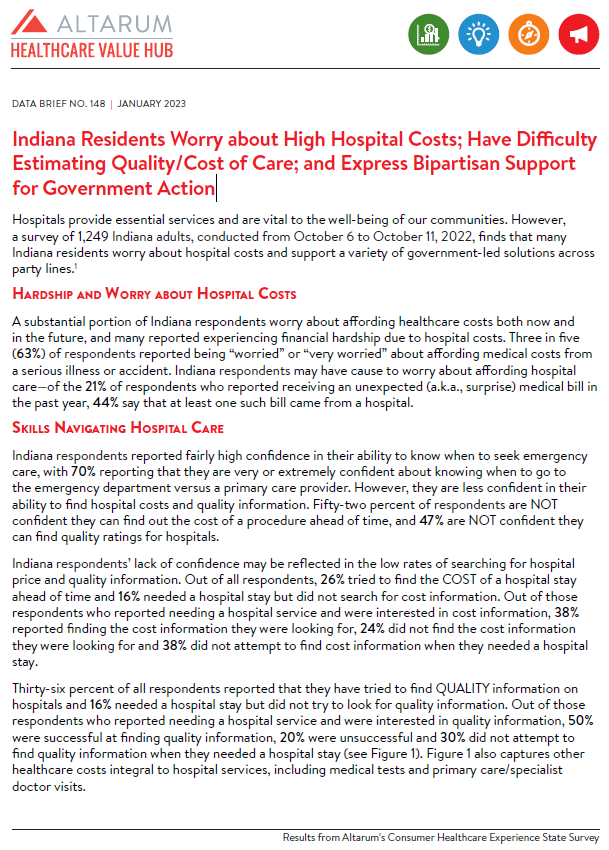Indiana Residents Worry about High Hospital Costs; Have Difficulty Estimating Quality/Cost of Care; and Express Bipartisan Support for Government Action
Hospitals provide essential services and are vital to the well-being of our communities. However, a survey of 1,249 Indiana adults, conducted from October 6 to October 11, 2022, finds that many Indiana residents worry about hospital costs and support a variety of government-led solutions across party lines.1
Hardship and Worry about Hospital Costs
A substantial portion of Indiana respondents worry about affording healthcare costs both now and in the future, and many reported experiencing financial hardship due to hospital costs. Three in five (63%) of respondents reported being “worried” or “very worried” about affording medical costs from a serious illness or accident. Indiana respondents may have cause to worry about affording hospital care—of the 21% of respondents who reported receiving an unexpected (a.k.a., surprise) medical bill in the past year, 44% say that at least one such bill came from a hospital.
Skills Navigating Hospital Care
Indiana respondents reported fairly high confidence in their ability to know when to seek emergency care, with 70% reporting that they are very or extremely confident about knowing when to go to the emergency department versus a primary care provider. However, they are less confident in their ability to find hospital costs and quality information. Fifty-two percent of respondents are NOT confident they can find out the cost of a procedure ahead of time, and 47% are NOT confident they can find quality ratings for hospitals.
Indiana respondents’ lack of confidence may be reflected in the low rates of searching for hospital price and quality information. Out of all respondents, 26% tried to find the COST of a hospital stay ahead of time and 16% needed a hospital stay but did not search for cost information. Out of those respondents who reported needing a hospital service and were interested in cost information, 38% reported finding the cost information they were looking for, 24% did not find the cost information they were looking for and 38% did not attempt to find cost information when they needed a hospital stay.
Thirty-six percent of all respondents reported that they have tried to find QUALITY information on hospitals and 16% needed a hospital stay but did not try to look for quality information. Out of those respondents who reported needing a hospital service and were interested in quality information, 50% were successful at finding quality information, 20% were unsuccessful and 30% did not attempt to find quality information when they needed a hospital stay (see Figure 1). Figure 1 also captures other healthcare costs integral to hospital services, including medical tests and primary care/specialist doctor visits.
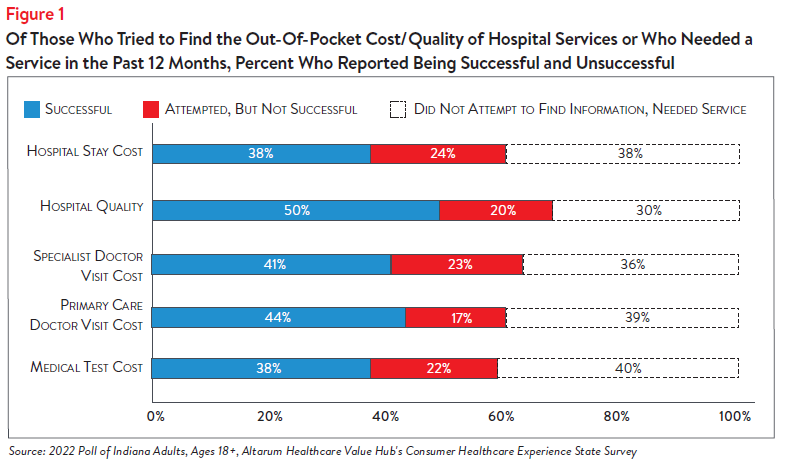
Among respondents who needed a hospital stay but did not seek out price or quality information, the most frequently reported reasons for not seeking information were:
- 37%–Followed their doctors’ recommendations or referrals
- 29%–The act of looking for information felt confusing or overwhelming
- 26%–Did not know where to look
- 19%–Did not have time to look
Notably, few of these respondents reported that out-of-pocket cost or quality were unimportant to them (11% and 7%, respectively).
Respondents who attempted to find hospital cost or quality information but were unsuccessful faced a variety of barriers. Among those who were unsuccessful searching for cost information, respondents reported that resources available to search for price information were confusing (42%), their insurance plan or provider, doctor or hospital would not give them a price estimate (32% and 32%, respectively) and that price information was insufficient (32%). In unsuccessful searches for hospital quality information, respondents reported that resources available to search for quality information were confusing (29%) and that the quality information available was not sufficient (22%).
Among those who were successful at finding hospital cost or quality information, over half reported not comparing prices or quality between providers (i.e. “shopping”). Still, 39% compared costs between multiple hospitals and 40% compared quality between multiple hospitals (see Figure 2 and Figure 3).
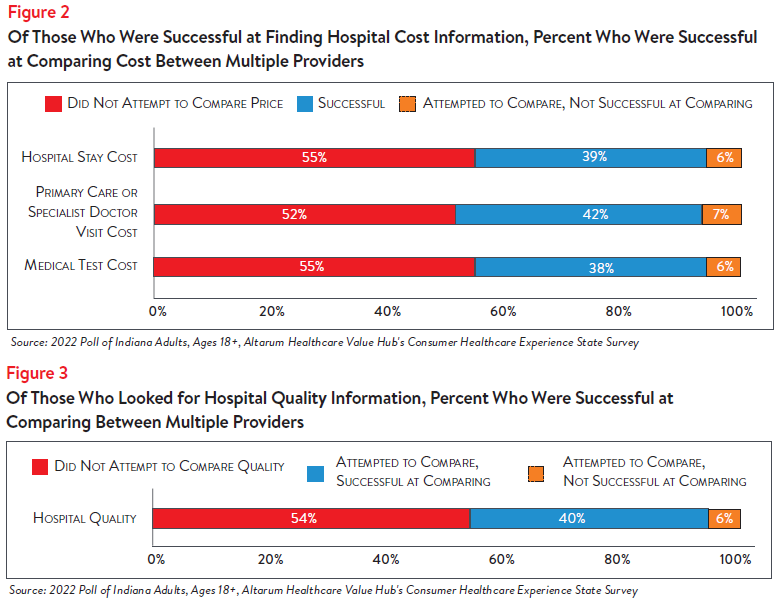
Among those that did compare cost or quality information for different services, many reported that the cost or quality comparison ultimately influenced their choice of which provider to seek care from. Eighty percent of 166 respondents who compared primary care or specialist doctor visit costs, 86% of 103 respondents who compared medical test costs and 92% of 73 respondents who compared hospital stay costs said the comparison influenced their choice. Among those who compared hospital quality information, 88% had their choice influenced by the information.
Although many of the respondents who sought out hospital price and quality information were ultimately successful, many respondents never attempted to find this information. Even among those who were successful at finding hospital cost or quality information, roughly half did not compare prices or quality between providers (i.e. “shopping”). Respondents identified a variety of barriers to finding and comparing cost and quality information, including following doctors’ recommendations, confusion over where or how to find cost or quality information and providers and insurers not providing cost estimates. These reasons could also be influenced by this information not being accessible, despite federal price transparency mandates for hospitals.2
It could also stem from the fact that some consumers don’t view healthcare as a shoppable commodity, especially in emergency situations and settings that lack a selection of treatments/providers. Lack of knowledge of hospital quality and potential costs impedes Indiana residents’ ability to plan for needed care and budget for the expense of a hospital stay, which can be costly,3 particularly for residents who are un- or under-insured.
Support for “Fixes” across Party Lines
Hospitals, along with drug manufacturers and insurance companies, are viewed as primary contributors to high healthcare costs. When given more than 20 options, those that Indiana respondents most frequently cited as being a “major reason” for high healthcare costs were:
- 75%–Drug companies charging too much money
- 72%–Hospitals charging too much money
- 69%–Insurance companies charging too much money
- 58%–Large hospitals or doctor groups using their influence to get higher payments from insurance companies
Indiana respondents strongly endorse a number of hospital-related strategies, including:
- 92%–Require hospitals and doctors to provide up-front cost estimates to consumers4
- 87%–Set standard payments to hospitals for specific procedures
- 86%–Impose price controls on contracts between insurers and healthcare providers
- 85%–Strengthen policies to drive more competition in healthcare markets to improve choice and access
- 85%–Set up an independent entity to rate doctor and hospital quality, such as patient outcomes and bedside manner
What’s even more interesting is the level of support for some of these strategies across party lines (see Table 1).
Conclusion
The findings from this poll suggest that Indiana respondents are somewhat motivated when it comes to searching for hospital cost and quality information to help inform purchasing decisions and plan for a future medical expense. However, Indiana respondents searched for hospital cost information less than specialist or primary care provider costs, and they were less successful at finding hospital cost than other services, despite recent action at the federal level to make hospital prices more transparent.5,6
It is not surprising that Indiana respondents express strong support for government-led solutions to make price and quality information more readily accessible and to help consumers navigate hospital care. Many of the solutions that respondents’ support would take the burden of research and guesswork off of consumers’ shoulders; by standardizing payments for specific hospital procedures, requiring hospitals and doctors to provide consumers cost estimates for certain procedures and establishing an entity to conduct independent quality reviews. Policymakers should investigate the evidence on these and other policy options to respond to Indiana respondents’ bipartisan call for government action.
Notes
- Percentages included in this brief are out of total number of respondents (N = 1,249) unless stated otherwise.
- As of January 1, 2021, the Centers for Medicare and Medicaid Services (CMS) requires hospitals to make public a machine-readable file containing a list of standard charges for all items and services provided by the hospital, as well as a consumer-friendly display of at least 300 shoppable services that a patient can schedule in advance. For more information, see: https://www.cms.gov/hospital-price-transparency/hospitals
- According to Health Forum, an affiliate of the American Hospital Association, hospital adjusted expenses per inpatient day in Indiana were $3,029 in 2020–above the national average. See: Kaiser Family Foundation, State Health Facts Data: Hospital Adjusted Expenses per Inpatient Day.
- Ibid.
- This survey was conducted after the Centers for Medicare and Medicaid Services’ rule requiring hospitals to publicly display all standard charges for all items and services, as well as shoppable services, in a consumer-friendly format went into effect. However, the well-documented low compliance from large hospitals indicates that the rule has yet to demonstrate the desired effect. See: Kelly, Susan, “Hospitals Still Fall Short on Price Transparency, Consumer Group Says,” Healthcare Dive (Aug. 10, 2022). See also: Kurani, Nisha, et al., Early Results from Federal Price Transparency Rule Show Difficulty in Estimating the Cost of Care, Kaiser Family Foundation, (April 9, 2021).
- Indiana Residents Experience Difficulty Estimating the Cost and Quality of Care; Express Bipartisan Support for Government Action, Healthcare Value Hub, Data Brief No. 146 (January 2023).
Methodology
Altarum’s Consumer Healthcare Experience State Survey (CHESS) is designed to elicit respondents’ unbiased views on a wide range of health system issues, including confidence using the health system, financial burden and possible policy solutions.
This survey, conducted from October 6 to October 11, 2022, used a web panel from online survey company Dynata with a demographically balanced sample of approximately 1,335 respondents who live in Indiana. The survey was conducted in English or Spanish and restricted to adults ages 18 and older. Respondents who finished the survey in less than half the median time were excluded from the final sample, leaving 1,249 cases for analysis. After those exclusions, the demographic composition of respondents was as follows, although not all demographic information has complete response rates:
